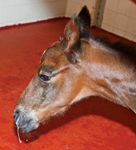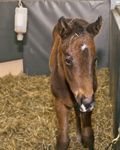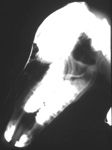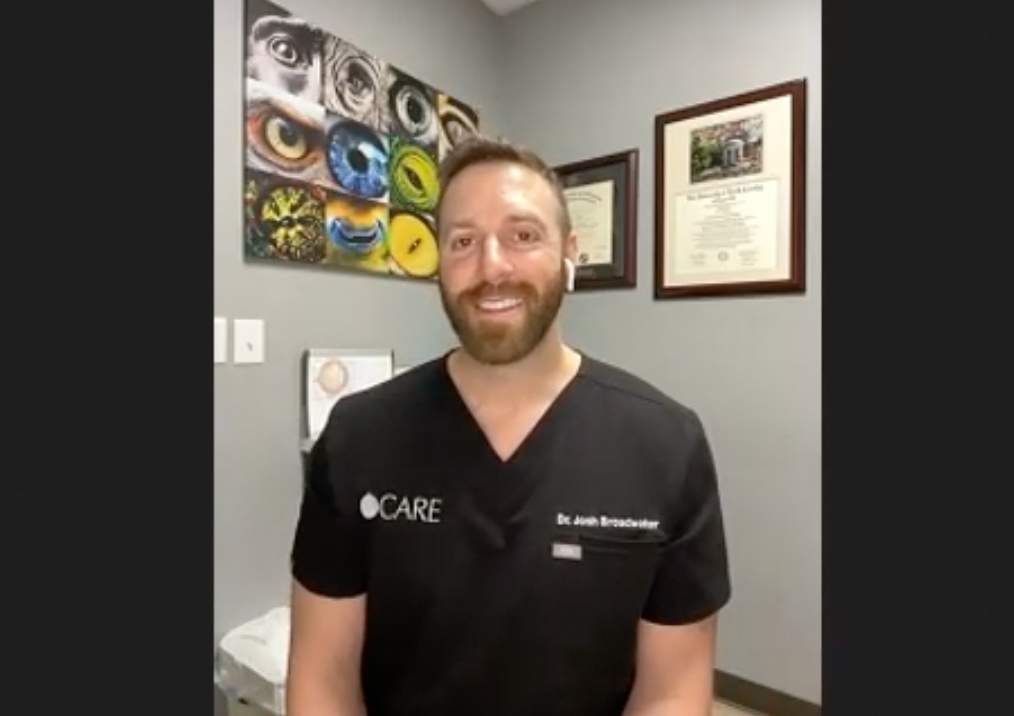Aspiration pneumonia in neonatal foals
Bacterial pneumonia is a common cause of disease in young foals.
Bacterial pneumonia is a common cause of disease in young foals. One source of infection frequently associated with neonates is the aspiration of foreign material. However, with early recognition and treatment, this condition does not have to progress to more serious disease or death.
"Pulmonary disease is more serious than upper respiratory disease in neonatal foals," says Jonathan Palmer, VMD, Dipl. ACVIM, chief of Neonatal Intensive Care Service at the University of Pennsylvania School of Veterinary Medicine's New Bolton Center. "We see upper airway problems in neonatal foals lead to lower lung problems such as aspiration pneumonia that are more serious, more life-threatening and perhaps cause more problems later in life."
Aspiration of foreign materials into the lung is a serious problem for young neonates, especially when the reasons for the aspiration are not addressed. "If you don't do something so that they stop aspirating, it can result in a fatal pneumonia," Palmer says.
Causes of aspiration pneumonia
"We see two types of aspiration pneumonia in neonatal foals," says Mary Rose Paradis, DVM, MS, Dipl. ACVIM, the section head of Large Animal Medicine & Surgery at Tufts University's Cummings School of Veterinary Medicine. The first is meconium aspiration, which is often seen after dystocia. "Those babies have a real tough time because there are chunks of fecal material in their lungs," Paradis states.

Photos 1 & 2: A dysphagic foal with milky nasal discharge after nursing. (PHOTOS: COURTESY OF DR. MARY ROSE PARADIS)
The other common situation is postpartum aspiration of milk. In these cases, as the foal nurses, milk may be seen discharged from its nose (Photos 1 & 2). "At that moment you have to decide, is the mare just producing a lot of milk and spraying the baby on the face, or is it actually dysphagia — improper swallowing?" says Paradis. After suckling, a small amount or several milliliters of milk may be expelled from the nostrils. "The important thing is not to take this clinical sign too lightly."

Photo 2
"It's important for practitioners to know that if they see milk come out of a young foal's nose, there may be aspiration," Palmer says.
A few things can result in milk aspiration. Although very rare in foals (about 1 percent of aspiration problems), it may be caused by a cleft palate. More common is pharyngeal dysfunction and/or dysphagia, especially in premature, weak foals or septic foals. When the foal attempts to swallow, it doesn't seal its larynx, so milk will go down the trachea, as well as out its nose. Pneumonia develops when milk is aspirated into the lungs. Milk is a nonsterile substance with a multitude of bacteria present and is a perfect bacterial growth media.
Another reason for milk regurgitation from the nose is a failure to clear the cervical esophagus of milk after drinking. The condition may be associated with neonatal encephalopathy or esophageal dysmotility. "Severely affected foals may have a large volume of milk flow from their noses, yet, because the problem is in the esophagus and not the pharynx or larynx, they will be able to guard their tracheae, and milk will not be aspirated," Palmer says. Therefore, it is important to determine the reason for the milk regurgitation.
If aspiration of milk is suspected "you need to do something to stop it," says Palmer. While these conditions may be transient, the foal should not be allowed to continue nursing if aspiration is confirmed (moist trachea, abnormal lung sounds).
Initial treatment and determining the underlying cause
One way to stop the aspiration of milk is to temporarily muzzle the foal, place an indwelling stomach tube and feed the foal this way for a few days while re-evaluating its condition. "If it does regain its ability to swallow, then it's on its way and can do well," Palmer says. "If it doesn't and continues to aspirate, then I've been most successful managing this by weaning the foal from the mare and feeding it from a bucket on the ground. As long as its head is below its lungs so that the fluid drains out its nose instead of down its trachea, it does all right." Once affected foals are able to eat solid food, the problem resolves.

Photo 3: A lateral skull radiograph with the soft palate displaced above the epiglottis. (PHOTOS: COURTESY OF DR. MARY ROSE PARADIS)
Determining the cause of the dysfunction is essential to guiding treatment. "There are two diagnostic tests that I find important — upper airway endoscopy and radiography," says Paradis. Endoscopy of the upper airway allows you to observe the function of the larynx and soft palate. Radiographic evaluation should include a lateral radiograph of the head, looking at the epiglottis in relationship to the soft palate to tell whether it's displaced (Photo 3), as well as radiographs of the chest to determine the extent of the aspiration pneumonia. Aspiration pneumonia tends to produce a distinctive radiographic pattern in the caudal ventral lung lobe (Photo 4).

Photo 4: A lateral radiograph of a foal with aspiration pneumonia. Note the bronchoalveolar pattern in the caudal ventral lung field. (PHOTOS: COURTESY OF DR. MARY ROSE PARADIS)
Most foals with dysphagia have a weakness in their soft palate causing dorsal displacement of the soft palate (DDSP) and sometimes a collapse of the pharyngeal walls. DDSP in foals may be due to prematurity or muscular weakness due to vitamin E or selenium deficiency, or it may be idiopathic. In severe cases, the foal will have difficulty breathing. In this situation, "it may be difficult to visualize the larynx due to the collapse of the pharyngeal walls. It is almost as if they're breathing through a space the size of a straw," Paradis says.
Since both dysphagia and aspiration pneumonia may be accompanied by increased respiratory effort, it is necessary to diagnose the cause. Endoscopic evaluation will help determine whether the respiratory difficulty is due to laryngeal or pharyngeal conditions such as DDSP and collapse of the pharynx or not.
Other conditions resulting in dysphagia and milk aspiration include pharyngeal or laryngeal cysts, laryngeal paralysis and arytenoiditis. A cyst can develop off the dorsal pharyngeal wall or underneath the soft palate. This causes a break in the seal of the larynx when the foal nurses. "Foals with laryngeal paralysis or arytenoiditis generally present in respiratory distress and often need an emergency tracheotomy," Paradis says.
Lastly, another differential diagnosis to consider is a congenital esophageal stricture. "This will prevent them from clearing their esophagus of milk," Palmer says. This is an uncommon cause of dysphagia that carries a poor prognosis.
Definitive treatment
The treatment and prognosis for milk aspiration depend on the cause. "The first step in treatment is to muzzle the foal and begin feeding through an indwelling stomach tube," says Paradis. "Next, broad-spectrum antibiotics are important to treat the pneumonia. For cases of DDSP, it is necessary to determine the cause. For example, if the DDSP is secondary to a vitamin E and selenium deficiency — also known as white muscle disease — and is confirmed by detection of elevated serum creatine kinase (CK) activity, you would treat with vitamin E and selenium. If you think the muscle weakness is due to prematurity, you should tube feed for a number of days, rechecking endoscopically or radiographically to see if there is resolution as the foal matures."
If a pharyngeal cyst is the cause of the dysphagia, then it needs to be removed. This can be accomplished easily with a laser. Be sure to continue to tube feed the foal until it heals. If laryngeal paralysis or arytenoiditis is the problem, the prognosis is poor. "You then need to be thinking about surgical intervention such as a tie-back surgery or arytenoidectomy with the knowledge that you may be creating a problem that can worsen the aspiration," says Paradis.
Most foals with aspiration pneumonia do well with proper treatment. "It's surprising how well neonatal foals recover from pulmonary disease." Palmer adds.
Ed Kane, PhD, is a researcher and consultant in animal nutrition. He is an author and editor on nutrition, physiology and veterinary medicine with a background in horses, pets and livestock. He is based in Seattle.
Podcast CE: A Surgeon’s Perspective on Current Trends for the Management of Osteoarthritis, Part 1
May 17th 2024David L. Dycus, DVM, MS, CCRP, DACVS joins Adam Christman, DVM, MBA, to discuss a proactive approach to the diagnosis of osteoarthritis and the best tools for general practice.
Listen











